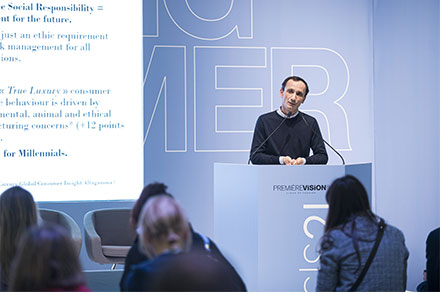Special report “A radical shift in consumer desires and behaviors” 1/3: Serge Carreira The - Fabrics - Première Vision Paris
Consumer desires are currently undergoing profound and unprecedented changes and fashion labels must respond to them if they are to remain desirable. We take a look at this disruption with Serge Carreira, Head of Emerging Brands Initiative at the Fédération de la Haute Couture et de la Mode and lecturer at Sciences-Po Paris.

Consumer desire is undergoing great change, exacerbated by the recent context. How would you define it? And how it is manifesting itself?
More than ever, consumers are demanding integrity. They want transparency, coherence and responsibility. This demand goes hand-in-hand with a sharp appetite for innovation. Fashion has to rhyme with fairness, authenticity and creativity. Already we are seeing that consumers are increasingly selective, moving away from brands and labels that they perceive as not being in line with these new expectations.
Has the virus simply accelerated matters or has it also shone a spotlight on them?
The acceleration is the result of this raising of awareness. Having this enforced pause led each and every one of us to reconsider our surroundings. There is a quest for meaning, a need for the usefulness of things.
Eco-responsibility now seems an essential, inescapable parameter. What does it change in the production chain and how must fashion houses transform to adapt to it?
Environmental responsibility will progressively impose itself as one of the determining criteria in the consumer decision-making process. It is getting stronger and is here to stay. And it is not limited to the type of textile; the entire chain must adapt, from agriculture for the raw materials to technological innovations for the recycling of materials to the energy consumption in stores. Most fashion houses need to adopt a global strategy. And it is not just a question of image. Although it can appear to be an investment, it is also a way of rationalising systems and generating savings in the long term. Indeed, fashion houses hold the key to their own development, as their own interests coincide with those of consumers.
Upcycling is also a growing trend. How can labels adapt and fight back?
There is no opposition to it, the question of recovering unsold stock and waste is crucial. In addition to the regulatory constraints, simply destroying items, which was a way some fashion houses chose to eliminate surplus stock, is no longer acceptable, as certain recent scandals have proven. Upcycling is a creative and responsible production process but it is not the only one. It is experiencing great success and designers, such as Marine Serre for example, have made it one of their signatures. Houses also adopt it to experiment with new ways of creating, like Weston with its project to repair old models. In contrast, some labels are focusing on other means of responsible development: innovative fabrics, natural fibres.
In addition, there is another growing movement, the desire for a more sober consumption. How must the fashion world adapt? By producing less but better?
One of the difficulties is that the word ‘fashion’ includes both designer labels and fast fashion, despite the fact that their two models are diametrically opposed. Fast fashion is based on high volumes and low prices – regardless of the social and environmental cost, at times – and the acceleration of cycles. Whereas for the most part, designer labels produce locally, in smaller volumes compared to the giants of fast fashion, with long development and design times. Global production must be substantially reduced and that mainly means fast fashion’s output.
A number of houses are working on this transformation, but isn’t there a shortage of communication about it? Does the consumer know today what they are really buying and towards which companies to turn to be in harmony with their convictions?
Just like for the food industry, transparency is everything. Labels will have to conform to these demands. The challenge for them is to find the right tone in order to share information about the traceability of products while keeping the dream alive.
What’s more, fashion addicts still exist. Will their number continue to decline? Changing behaviour is also a question of education. Who is responsible for this aspect, in your opinion?
There is still a strong appetite for fashion, particularly with the young generation. It is not a question of reducing growth but rather ensuring the emergence of a more selective, more committed and more thoughtful form of mass consumption. The new ways of “doing fashion” will guide behaviour.
Fashion is also attractive because it is synonymous with the avant-garde. Is it not strange to see fashion overwhelmed by certain developments that it had probably not anticipated?
The current transformations are unprecedented. From digital to new consumer expectations, a number of nascent phenomena are accelerating. Some players can find themselves left behind. The collapse of certain American distributors, well before the crisis, shows that this was already underway. Some designers, in particularly, are already up to speed on the challenges of today.
In any case, many designers share this desire for change, notably in terms of the rhythms of collections.
The resonance of this question differs according to whether the fashion house has its own distribution network or not. In addition to the need to further rationalize the supply chain, with longer development times for the design aspect, one of the major problems is the lifespan of collections in shops. The dates of sales have been brought forward in recent years, notably in the United States and online, and this has considerably reduced the length of time a product is sold at full price. This generates a constant demand for new items to replace those that were discounted a few weeks after delivery. The idea that products can remain at full price for a number of months is just starting to be imposed by a growing number of fashion houses.
But the sales are something everyone looks forward to!
Retailers have created this almost addictive dependence on discounting in their clients, with the incessant need to make room for new arrivals of stock. We need to rehabilitate the value of the product, its “fair” price. It needs to be revalued. The success of limited editions and strong products shows the consumers are ready to pay when the perceived value is high.
In addition, I think about the question of diversity, which is a major subject of discussion in society these days, but which for years had been mostly avoided. Did fashion not miss out on a major movement?
Already in the last few years, the sector had started transforming its approach to respect and diversity. No doubt, there is still much to do, whether in terms of parity, equality or visibility of diversity. Primarily, it means changing mentalities. From this point of view, the young generations are the pioneers. They are active on the question of gender, acceptation of sexual orientation and respect for diversity. More than just well-meaning words, consumers want to see actions from labels as well as the media and advertisers.
Has fashion experienced such disruption in the past? Do you think it is capable of adapting?
If a historical parallel were to be drawn, we could compare the current period with the 1920s when everything needed to be rebuilt on the ruins of the First World War. It was a period of innovation, experimentation and creation that accompanied and amplified the changes in lifestyles and behaviours at the time. Modernism was a radical change compared to the world inherited from the 19th Century.
Do you think these essential developments are compatible with what we all love about fashion, namely its creativity? It is a driver or a brake? Can fashion still make us dream?
I would say even more so. If fashion is a dream it is because through creation it is able to reflect its era. Obviously, we are seeing ruptures of certain pre-established orders but that should indeed be the impetus that drives the imagination of designers. Only those that can demonstrate their agility by integrating the challenges of our times will continue to be desired.
What is the future of fashion, in your opinion?
We cannot ignore that in the short-term things are going to be extremely difficult. However, I believe that what is happening is an exceptional opportunity for houses that truly endorse strong values of creation to find new opportunities.
More Special report “A radical shift in consumer desires and behaviors”


3/3 : Read the testimony of Katell Pouliquen, Editorial director of Marie-Claire here
And download here the complete Cloud of Fashion Newspaper:
70 pages of analyses and 360° strategies to meet the new challenges of fashion.
